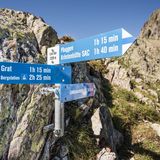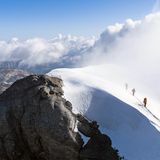
© Bruno Hasler
Safety when mountaineering Ten useful tips
Mountaineering offers great opportunities to discover nature, share experiences, take on responsibilities and enjoy adventures. The following advice will help you deal with any dangers you may have to face when mountaineering.
These ten points are based on the recommendations made by the CAA and have been completed by the SAC training and safety experts. However, they can’t replace training courses, which provide a solid base and help you expand your competences and improve your technique with qualified instructors.
10 Tips
1. Fit and healthy
Mountaineering is an endurance sport practised at high altitude. The effort it demands, for the heart, circulation muscles and articulations, requires you to be in good health and to be able to assess your abilities. Avoid being pushed by time and adopt a pace suitable for all members of the group.
2. Acclimatisation
Over 2500 meters, the human body needs time to adapt to the altitude. It is therefore essential to climb slowly and to gradually increase the altitude at which you sleep. Should you experience signs of altitude sickness (e.g. headaches, dizziness, nausea), the best thing to do is to go back down.
3. Careful planning
Information about distance, height differences, the level of difficulty and the conditions can be found on maps, in guide books, online or by asking experts. The weather forecast is particularly important as storms, snow, wind and cold weather can greatly increase the risk of accidents. Make sure that the itinerary is adapted to the level of the group and always plan alternative ones. Take note of the emergency mountain rescue phone numbers of the country (REGA: 1414; European emergency number: 112).
4. Stick to small groups
The ability, experience and motivation of the group members, as well as the size of the group, will influence the choice of where to go. The ideal size is 2 to 6 people; a larger group is riskier. It is not recommended to go alone. Make sure a family member knows your destination, what itinerary you have planned and when you expect to be back.
5. Proper equipment
Make sure that you have the correct equipment and that your rucksack is not too heavy. A rope and a helmet will protect you from slipping and from rockfalls, crampons and an ice axe will give you a better grip. Don’t forget sun cream either. Make sure that you take a first aid kit, a survival blanket, a mobile phone and a head lamp with you – you’ll be happy to have them on you in case of an emergency.
6. Check the present conditions
Receding glaciers, melting snow and the rising limit of freezing level increase the risk of rockfalls or of falling into a crevasse. You should therefore set off early enough, keep checking the current weather and conditions and adapt your itinerary accordingly.
7. Keep checking your direction
Orientation can be difficult when there is no path, on glaciers or when visibility is poor. It is very important to know how to read the map and use an altimeter, compass and GPS. If in doubt, turn back before it’s too late!
8. Rope up on glaciers, belay on exposed ground
If you plan to go mountaineering on snowy and icy slopes or on rocky ridges you must master belaying and rescue techniques. If an alpinist falls into a crevasse, the roped party can break his fall. NB If you are roped up on a steep slope, there is a risk of being dragged down if there is an accident.
9. Be sure-footed
It doesn’t take much to fall – we all stumble and slip sometimes. Falls are the main cause of accidents! Bear in mind that fatigue and a sustained pace considerably reduce your concentration and the steadiness of your steps. Using your crampons and ice axe properly requires lots of practice.
10. Respect for nature and the environment
High mountain areas are a precious place for discovering the uniqueness of nature. Appreciate this freedom and respect the fragile environment. Pay attention to others and support environmental organisations.

